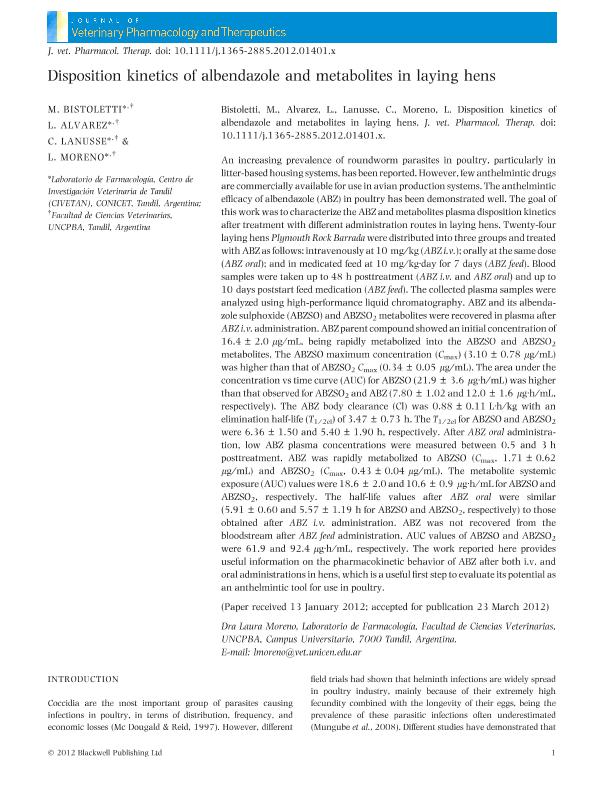Mostrar el registro sencillo del ítem
dc.contributor.author
Bistoletti, Mariana

dc.contributor.author
Alvarez, Luis Ignacio

dc.contributor.author
Lanusse, Carlos Edmundo

dc.contributor.author
Moreno Torrejon, Laura

dc.date.available
2016-03-09T17:54:10Z
dc.date.issued
2013-03
dc.identifier.citation
Bistoletti, Mariana; Alvarez, Luis Ignacio; Lanusse, Carlos Edmundo; Moreno Torrejon, Laura; Disposition kinetics of albendazole and metabolites in laying hens; Wiley; Journal of Veterinary Pharmacology and Therapeutics; 36; 2; 3-2013; 161-168
dc.identifier.issn
0140-7783
dc.identifier.uri
http://hdl.handle.net/11336/4703
dc.description.abstract
An increasing prevalence of roundworm parasites in poultry, particularly in litter-based housing systems, has been reported. However, few anthelmintic drugs are commercially available for use in avian production systems. The anthelmintic efficacy of albendazole (ABZ) in poultry has been demonstrated well. The goal of this work was to characterize the ABZ and metabolites plasma disposition kinetics after treatment with different administration routes in laying hens. Twenty-four laying hens Plymouth Rock Barrada were distributed into three groups and treated with ABZ as follows: intravenously at 10 mg⁄ kg (ABZ i.v.); orally at the same dose (ABZ oral); and in medicated feed at 10 mgÆkg ⁄ day for 7 days (ABZ feed). Blood samples were taken up to 48 h posttreatment (ABZ i.v. and ABZ oral) and up to 10 days poststart feed medication (ABZ feed). The collected plasma samples were analyzed using high-performance liquid chromatography. ABZ and its albenda-zole sulphoxide (ABZSO) and ABZSO2 metabolites were recovered in plasma after ABZ i.v. administration.ABZ parent compound showed an initial concentration of 16.4 ± 2.0 lg ⁄ mL, being rapidly metabolized into the ABZSO and ABZSO2 metabolites. The ABZSO maximum concentration (Cmax) (3.10 ± 0.78 lg ⁄ mL)was higher than that of ABZSO2 Cmax (0.34 ± 0.05 lg ⁄ mL). The area under the concentration vs time curve (AUC) for ABZSO (21.9 ± 3.6 lgÆh⁄ mL) was higher than that observed for ABZSO2 and ABZ (7.80 ± 1.02 and 12.0 ± 1.6 lgÆh⁄ mL, respectively). The ABZ body clearance (Cl) was 0.88 ± 0.11 LÆh⁄ kg with an elimination half-life (T1 ⁄ 2el) of 3.47 ± 0.73 h. The T1 ⁄ 2el for ABZSO and ABZSO2 were 6.36 ± 1.50 and 5.40 ± 1.90 h, respectively. After ABZ oral administration, low ABZ plasma concentrations were measured between 0.5 and 3 h posttreatment. ABZ was rapidly metabolized to ABZSO (Cmax, 1.71 ± 0.62 lg ⁄ mL) and ABZSO2 (Cmax, 0.43 ± 0.04 lg ⁄ mL). The metabolite systemic exposure (AUC) values were 18.6 ± 2.0 and 10.6 ± 0.9 lgÆh⁄ mL for ABZSO and ABZSO2, respectively. The half-life values after ABZ oral were similar (5.91 ± 0.60 and 5.57 ± 1.19 h for ABZSO and ABZSO2, respectively) to those obtained after ABZ i.v. administration. ABZ was not recovered from the bloodstream after ABZ feed administration. AUC values of ABZSO and ABZSO2 were 61.9 and 92.4 lgÆh⁄ mL, respectively. The work reported here provides useful information on the pharmacokinetic behavior of ABZ after both i.v. and oral administrations in hens, which is a useful first step to evaluate its potential as an anthelmintic tool for use in poultry.
dc.format
application/pdf
dc.language.iso
eng
dc.publisher
Wiley

dc.rights
info:eu-repo/semantics/openAccess
dc.rights.uri
https://creativecommons.org/licenses/by-nc-sa/2.5/ar/
dc.subject
Albendazole
dc.subject
Laying Hens
dc.subject
Disposition Kinetics
dc.subject.classification
Ciencias Veterinarias

dc.subject.classification
Ciencias Veterinarias

dc.subject.classification
CIENCIAS AGRÍCOLAS

dc.title
Disposition kinetics of albendazole and metabolites in laying hens
dc.type
info:eu-repo/semantics/article
dc.type
info:ar-repo/semantics/artículo
dc.type
info:eu-repo/semantics/publishedVersion
dc.date.updated
2016-03-30 10:35:44.97925-03
dc.journal.volume
36
dc.journal.number
2
dc.journal.pagination
161-168
dc.journal.pais
Estados Unidos

dc.journal.ciudad
Hoboken
dc.description.fil
Fil: Bistoletti, Mariana. Consejo Nacional de Investigaciones Científicas y Técnicas. Centro Científico Tecnológico Tandil. Centro de Investigacion Veterinaria de Tandil; Argentina. Universidad Nacional del Centro de la Provincia de Buenos Aires.. Facultad de Ciencias Veterinarias; Argentina
dc.description.fil
Fil: Alvarez, Luis Ignacio. Consejo Nacional de Investigaciones Científicas y Técnicas. Centro Científico Tecnológico Tandil. Centro de Investigacion Veterinaria de Tandil; Argentina. Universidad Nacional del Centro de la Provincia de Buenos Aires.. Facultad de Ciencias Veterinarias; Argentina
dc.description.fil
Fil: Lanusse, Carlos Edmundo. Consejo Nacional de Investigaciones Científicas y Técnicas. Centro Científico Tecnológico Tandil. Centro de Investigacion Veterinaria de Tandil; Argentina. Universidad Nacional del Centro de la Provincia de Buenos Aires.. Facultad de Ciencias Veterinarias; Argentina
dc.description.fil
Fil: Moreno Torrejon, Laura. Consejo Nacional de Investigaciones Científicas y Técnicas. Centro Científico Tecnológico Tandil. Centro de Investigacion Veterinaria de Tandil; Argentina. Universidad Nacional del Centro de la Provincia de Buenos Aires.. Facultad de Ciencias Veterinarias; Argentina
dc.journal.title
Journal of Veterinary Pharmacology and Therapeutics

dc.relation.alternativeid
info:eu-repo/semantics/altIdentifier/url/http://onlinelibrary.wiley.com/doi/10.1111/j.1365-2885.2012.01401.x/abstract;jsessionid=138631F301195CB74D1F216BC138BB57.f03t02
dc.relation.alternativeid
info:eu-repo/semantics/altIdentifier/doi/http://dx.doi.org/10.1111/j.1365-2885.2012.01401.x
dc.relation.alternativeid
info:eu-repo/semantics/altIdentifier/issn/0140-7783
Archivos asociados
